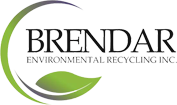What do I do with my Hazardous Wastes?
Residential Hazardous Wastes – household hazardous wastes programs have been operating in Ontario since the mid 1980′s. These collections programs are typically offered by participating municipalities wishing to provide their residents with a safe, responsible option for disposing of the their household hazardous wastes. Depending of the size of the municipality these programs can range in scope from single-day events to permanent drop-off depots that are open 5 days/wk. To find out where your nearest Household Hazardous Waste drop-off is located, visit www.dowhatyoucan.ca.
Industrial, Commercial and Institutional – If your company/organization generates hazardous wastes you will need to register your company with the Ministry of the Environment (www.hwin.ca) and then contract a licensed hazardous waste service provider (like Brendar) to assist with both the transportation and disposal of these materials. If you would like more information specific to your company's wastes and situation please feel free to contact us.
How are Hazardous Waste managed?
The practical side of the waste management process is a blend of practices and regulations. Let's begin with the Regulations; the provincial Ministry of the Environment of Ontario (MOE) Regulation 347 and the federal Transportation of Dangerous Goods.
Firstly, the waste materials are gathered together by the Generator, which is the name for the company with the wastes. They must be registered with the MOE before any movement of materials can happen.
The materials are required to be shipped and received by Ministry of the Environment of Ontario (MOE) licenced companies. This means the Transporter (i.e. trucking company) must be licenced by the MOE and the company getting the waste (the receiver) must also be licenced by the MOE.
Not following these rules is illegal and all the companies involved in sending, transporting and receiving the wastes can potentially be charged if these rules are not followed. As with all things there are certain exemptions for very specific materials but this is the general rule for virtually all hazardous wastes shipped from most industries.
The MOE controls this process by a manifest tracking system that monitors who is involved and what materials and volumes are being shipped. Every shipment of hazardous waste in the province of Ontario is required to be manifested and the documentation forwarded to the MOE. That's a lot of manifests. To help with this, the MOE has initiated an electronic manifest system – the first in North America. This internet based system can be used by companies that have internet access at their shipping locations.
The MOE also wants to know what is being shipped and to do this they have a series of "waste classes" which describe the materials. This information along with the volumes are put onto the manifest form and tracked. Although there is much more involved in this registering, licencing, and manifesting system the details here provide a fair overview of the general requirements as set out by the MOE.
The second regulation referenced is the federal Transportation of Dangerous Goods (TDG) Regulation prepared by Transport Canada. This regulation, which was initiated as a result of the 1979 Mississauga train derailment, addresses what warning information is required for the goods being transported. This regulation identifies that trained personnel should be used and it identifies what information should be on the shipping containers, paperwork and the vehicles transporting them. The manifest is used to incorporate this information when shipping hazardous waste materials.
When Brendar Environmental handles these wastes we sort the chemicals by their chemical compatibilities and then put them in containers (usually drums) so they will not react with other materials. These groupings form the basis of how we identify the drum, label it, and document it for shipping. Our personnel responsible for transporting these materials are trained under MOE Regulation 347 and the Transportation of Dangerous Goods to do this work.
What happens to these hazardous wastes?
There are some other practical considerations when we handle these wastes. One, already mentioned is the chemical compatibility, but some other items include the volume of the material and the capabilities of the company receiving the material.
Volumes of material: The hazardous waste management process is about "bulking up" volumes so that they can be processed efficiently. A facility cannot effectively handle many small containers directly from your household, so they are first sorted out into "like and compatible" materials. They are then poured/ scraped/ bulked into drums. Once many drums are collected, these materials can then be taken to another processing facility where they can be "bulked up" into a larger tanks/ containers. Now, the large facilities can handle these materials with a higher-volume focus, which is more efficient for the receivers to process and recycle (where possible).
Example: 1 litre to 4 litre containers of solvents for cleaning paint brushes
These containers are poured/ scraped into drums. After many drums are collected (perhaps 25-100 drums) the solvent material can then be pumped from the drums with a vacuum truck. This material is now sent to another company that blends thousands of litres of similar solvents to make them into a consistent fuel that can be utilized for its heat value in a cement kiln. This replaces using new resources while disposing of a "waste product" thereby using this material one last time before destroying it.
Although not all materials can be re-used/recycled in this fashion, the bulking up process is generally similar among most materials including paint, oil, antifreeze, acids, bases, batteries, pesticides, and fertilizers.
If you take this information as a general understanding of the "process" that is undertaken in the waste management industry we will have been successful in this educational segment.
Thank you for your interest in Brendar Environmental Inc.

